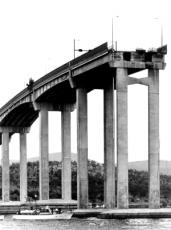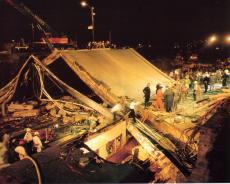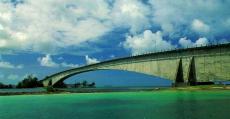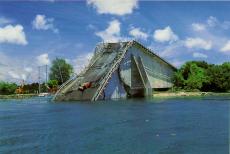Bridges that collapse…
 The idea that some bridges collapse is fascinating: when I cross the largest bridges in Australia – Sydney’s wonderful and famous Harbour Bridge, the Gateway Bridge in Brisbane, Melbourne’s Westgate Bridge and the Tasman Bridge in Hobart – I can only rarely suppress a primeval shudder.
The idea that some bridges collapse is fascinating: when I cross the largest bridges in Australia – Sydney’s wonderful and famous Harbour Bridge, the Gateway Bridge in Brisbane, Melbourne’s Westgate Bridge and the Tasman Bridge in Hobart – I can only rarely suppress a primeval shudder.
Why? Because I am always waiting for the damn thing to fall down.
And after all, three spans of the Tasman bridge collapsed in 1975 when the bulk ore ship MV Lake Illawarra struck two pylons. Five occupants of cars crossing the bridge were killed, and the ship – with massive sections of concrete lying across her – sank, killing all seven crewmembers.
And, while it was being built, a 135-metre section of the Westgate bridge – the bit weighing 2000 tonnes – fell to the ground, killing 35 of the workmen involved in its construction.
Then there’s the Bold Street bridge in Granville, Sydney, which collapsed after being impacted by a derailed train passing beneath. Eighty-three people died when the four-lane concrete bridge – weighing 570 tonnes – fell on the railway carriages.
So perhaps it’s not so odd that I don’t have quite the implicit faith in bridges that others seem to have.
The Australian bridges didn’t fall down because of inadequate design (perhaps the Westgate disaster excepted) or maintenance. Nope it took ships or trains running into bridge supports to cause the collapse of magnificent, finished structures.
So have there been other major bridge collapses where simply inadequate design or construction was at fault? The answer to that is not at all reassuring to my shivers – yes, there have been.
The most spectacular occurred to a bridge only 19 years old. The Koror-Babeldaob Bridge, in the Republic of Palau, Micronesia, was completed in 1977. It collapsed without warning in September, 1996. Perhaps because of its remote location – in the Western Pacific, 1200km north of Papua New Guinea and 850km south-east of the Philippines – the bridge failure didn’t attract the same media attention that would have resulted had the bridge been in a major Western city.
It might have later collapsed, but to the eye this was certainly no amateur construction. With a main span of 240.8 meters, it was at the time the longest post-tensioned concrete box girder bridge in the world. Designed in 1975 by Alfred A Yee and Associates of Honolulu, the bridge consisted of three spans – the central 240.8 span, and two side spans, each of 53.6 metres. Extensions of each side span towards the land comprised 18.6 metres; in total, the structure was a considerable 385.2 metres in length.
As the name suggests, the massive structure was actually mostly air – a box girder has nothing in the middle. This typical cross-sectional diagram (as with most of the other technical material in this column, sourced from an MSc Dissertation at the Imperial College, London, penned by Matthias Pilz), shows the 36cm side wall thickness of the box section, the section being 3.66 metre high at the centre of the bridge.
Very importantly, while it appears to the eye that the main span was an arch bridge, that is not the case. In fact, at the centre of the bridge there was effectively a gap – each side of the centre span was supported only from one end, making this a double cantilever design.
It wasn’t long after construction than problems started to occur. The centre span of the bridge deflected – it was sagging in the middle. Two engineering studies were carried out, both concluding that the bridge remained safe. However, in 1993 a third study was commissioned which estimated that the bridge would continue to sag – perhaps another 0.85 metres over the next 85 years. But by 1996 it had drooped by 1.2 metres! That study had recommended the strengthening of the bridge, though still retaining its basic cantilever design.
Ho wever, the repairs that were actually carried out adopted a completely different approach. These involved connecting together the two halves of the centre span, effectively making this section of the bridge one complete unit – that is, changing the design from a cantilever to an arch bridge. Rather than the forces acting on the bridge simultaneously attempting to stretch the upper parts of the box section and compress the lower parts, the arch design caused compression of both upper and lower parts of the box section.
wever, the repairs that were actually carried out adopted a completely different approach. These involved connecting together the two halves of the centre span, effectively making this section of the bridge one complete unit – that is, changing the design from a cantilever to an arch bridge. Rather than the forces acting on the bridge simultaneously attempting to stretch the upper parts of the box section and compress the lower parts, the arch design caused compression of both upper and lower parts of the box section.
Whether this was a good idea or not can perhaps be best judged by the outcome: on September 26, 1996, three months after the bridge repairs were completed, the central span of the Koror-Babeldaob Bridge completely collapsed.
Why the bridge actually fell down is still being discussed. One theory is that the concrete on the upper side of the box section had lost its ability to withstand compressive forces – and with no other means of support, once this concrete started to crumble, the whole span was lost. Others suggest that the stresses acting on the concrete – in either cantilever or arch bridge forms – should not have been too great for the material to withstand, even if the concrete was of poor quality. However, these calculations assume that the concrete was not cracked: if the upper deck was cracked, then its ability to withstand the new stresses after the alteration in bridge design would have been low.
While the ‘whys’ are very important in preventing other similar bridge collapses occurring, the bottom line is that a modern, apparently well-designed and constructed bridge that was only 19 years old collapsed with no warning.
And then of course there’s that other, much better known, construction that fell down – the I-35W Mississippi River Bridge.
Gawd, no wonder I can’t stop that shiver when I travel over big bridges…

 Julian Edgar, 50, has been writing about car modification and automotive technology for nearly 25 years. He has owned cars with two, three, four, five, six and eight cylinders; single turbo, twin turbo, supercharged, diesel and hybrid electric drivelines. He lists his transport interests as turbocharging, aerodynamics, suspension design and human-powered vehicles.
Julian Edgar, 50, has been writing about car modification and automotive technology for nearly 25 years. He has owned cars with two, three, four, five, six and eight cylinders; single turbo, twin turbo, supercharged, diesel and hybrid electric drivelines. He lists his transport interests as turbocharging, aerodynamics, suspension design and human-powered vehicles.





on March 11th, 2008 at 8:33 am
Hi, I enjoyed your article on Bridges that collapse but found it incomplete without a mention of the Tacoma Narrows Bridge http://en.wikipedia.org/wiki/Tacoma_Narrows_Bridge The video is a must see. I first witnessed it as an engineering student during the 80’s and I expect it is still shown.
Rob
on March 11th, 2008 at 12:27 pm
It most definitely is Rob. I just finished my engineering studies last year and have seen the footage a number of times in a number of subjects. I agree, Tacoma Narrows definitely needs a mention.
on March 18th, 2008 at 7:35 pm
For you and anyone interested in these sorts of engineering failures there are two excellent books that provide explanations for lay people one called Why Buildings Stand Up: The Strength of Architecture by Mario Salvadori and Why Buildings Fall Down: How Structures Fail by Salvadori and some co-authors.
The latter especially gives the engineering & technical explanations for a number of well-known failures from ancient to modern times including the Tacoma Narrows failure.
Both give accessible and understandable descriptions of the general principles that apply to each structure then move to a specific analysis of why a failure occurred – or why the structure remains standing.
on March 19th, 2008 at 11:45 am
No doubt you have heard of the bridges in Brisbane which while not collapsing are in fact sinking. A prime example can be seen on the inner city bypass in Brisbane heading towards Kingsford smith drive.Just on the Bowen Bridge road off ramp the whole structure has been steadily sinking sinking since it was completed a few years ago. The local authorities basically just don’t mention it and fill the gaps with bitumin. It must almost 3 feet thick in places now.
Cheers…and drive carefully on the ICB…LOL!